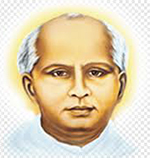|
Mother Teresa was born on August 27,1910 in Skopje, Macedonia. Her original name was Agnes Gonxha Bojaxhiu. The youngest of the children born to Nikola and Drane Bojaxhiu, her father was a successful merchant and she was youngest of the three siblings. She received her First Communion at the age of five and a half and was confirmed in November 1916. From the day of her First Holy Communion, a love for souls was within her. Her father’s sudden death when Gonxha was about eight years old left the family in financial straits. Drane raised her children firmly and lovingly, greatly influencing her daughter’s character and vocation. Gonxha’s religious formation was further assisted by the vibrant Jesuit parish of the Sacred Heart in which she was much involved. At the age of 12, she decided that she wanted to be a missionary and spread the love of Christ. At the age of 18 she left her parental home in Skopje and joined the Sisters of Loreto, an Irish community of nuns with missions in India. There she received the name Sister Mary Teresa after St. Thérèse of Lisieux. After a few months of training at the Institute of the Blessed Virgin Mary in Dublin Mother Teresa came to India on 6 January 1929. On May 24, 1931, she took her initial vows as a nun. From 1931 to 1948, she taught geography and catechism at St. Mary's High School in Calcutta. On 24 May 1937, she made her Final Profession of Vows, becoming, as she said, the “spouse of Jesus” for “all eternity.” From that time on she was called Mother Teresa. She continued teaching at St. Mary’s and in 1944 became the school’s principal. A person of profound prayer and deep love for her religious sisters and her students, Mother Teresa’s twenty years in Loreto were filled with profound happiness. Noted for her charity, unselfishness and courage, her capacity for hard work and a natural talent for organization, she lived out her consecration to Jesus, in the midst of her companions, with fidelity and joy. On 10 September 1946 Mother Teresa got a call from Jesus to abandon teaching and to work in the slums of Culcutta. In January 1948 she got the permission to leave Loreto convent and to work for the unwanted, the unloved and the uncared. In 1957 she started the religious congregation for sisters called the Missionaries of Charity. Mother Teresa has received 124 awards and the important among them include the following.
1962 - Padmasree
1971 - Pope John Paul XXIII Peace Prize
1971 - John F Kennedy International Award
1972 - Jawaharlal Nehru Award for International Understanding
1973 - Templeton Prize for Progress in Religion
1979 - Nobel Peace Prize
1980 - Bharat Ratna
1983 - Order of Merit from Queen Elizebeth
1987 - Gold medal of the Soviet Peace Committee
1997 - United States Congressional Gold Medal
|
|
The whole of Mother Teresa’s life and labour bore witness to the joy of loving, the greatness and dignity of every human person, the value of little things done faithfully and with love, and the surpassing worth of friendship with God. On March 13, 1997, Mother Teresa stepped down from the head of Missionaries of Charity. She died on September 5, 1997, just 9 days after her 87th birthday. She was given the honour of a state funeral by the Government of India and her body was buried in the Mother House of the Missionaries of Charity. Her tomb quickly became a place of pilgrimage and prayer for people of all faiths, rich and poor alike. Mother Teresa left a testament of unshakable faith, invincible hope and extraordinary charity. Her response to Jesus’ plea, “Come, be My light,” made her a Missionary of Charity, a “mother to the poor,” a symbol of compassion to the world, and a living witness to the thirsting love of God. Following Mother Teresa's death, the Holy See began the process of her canonisation. In 2002 Vatican recognized a miracle through which an Indian woman Monica Besra was cured of abdominal tumor though the intercession of Mother Teresa. On 19 October 2003 she was beatified by Pope John Paul II. On 17 Decemer 2015 Pope Francis recognized a second miracle thogh her intercession. It was healing of a Belgian man named Marcilio Andrino who was in coma due to a viral brain infection. On 4 September 2016 Pope Francis declared Mother Teresa a Saint.
|
|


